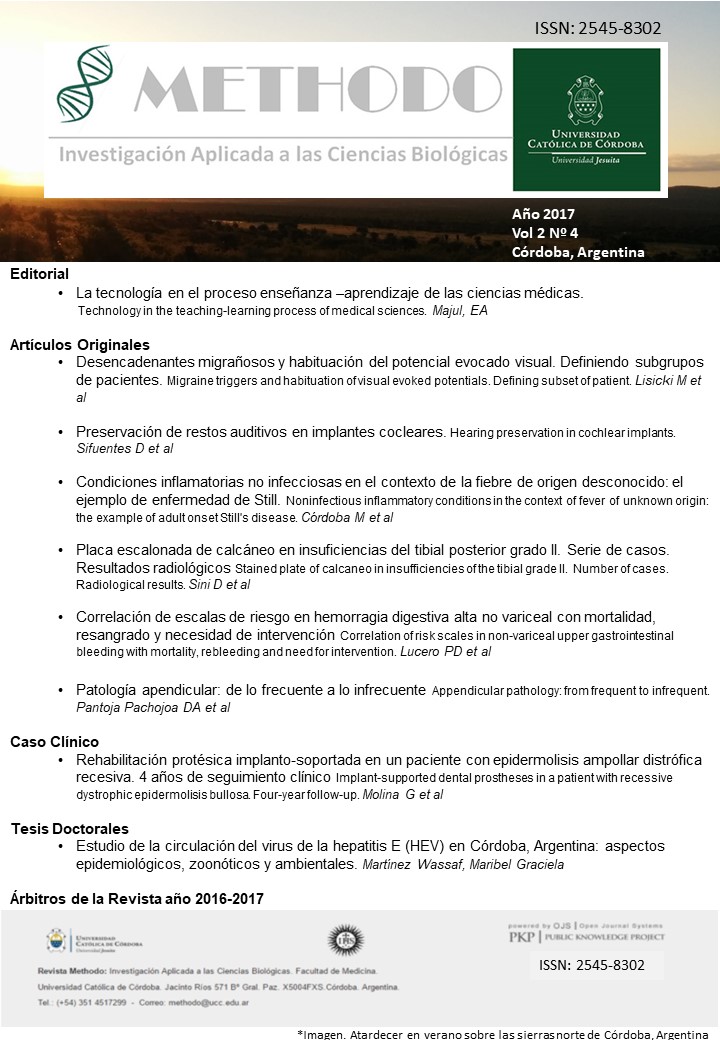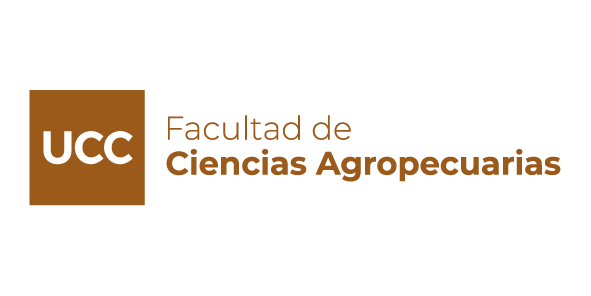Evaluación nutricional y tecnológica de harinas de cereales y pseudocereales libres de gluten, a partir de análisis composicionales y ensayos fisicoquímicos
Palabras clave:
harinas, productos libres de gluten, maíz, quínoa, amaranto, arroz, almidónResumen
Harinas libres de gluten como las provenientes del arroz, el maíz y pseudocereales como la quínoa y el amaranto son importantes de caracterizar como materia prima, no sólo para la elaboración de productos destinados a quienes padecen enfermedades relacionadas a la intolerancia al gluten, sino también en el impacto de las mismas en la salud humana cuando son consumidas por la población en general, principalmente en la posibilidad de influir en el aporte energético o la aparición de desórdenes metabólicos. Estas cuestiones son siempre importantes de analizar cuando se trata de materias primas con cantidades muy altas de hidratos de carbono, representados en este caso por el almidón. Pero no solo lo relacionado con la nutrición y la salud es importante de analizar. Cuando de factibilidad en la utilización de materias primas se habla, el componente tecnológico es muy significativo. La temperatura de gelatinización y de retrogradación del almidón, parámetros visco-elásticos, entre otros, son factores que afectan la calidad del producto final elaborado a partir de farináceos, cuya utilización en productos como los panificados representa en sí mismo un desafío tecnológico muy importante, afectado por la necesidad de mimetizar los efectos tecnológicos del gluten ausente. Para llevar a cabo lo presentado, se pretende realizar un análisis composicional de las muestras, incluyendo determinaciones de las concentraciones de macronutrientes, tales como proteínas y almidón, así como también de las concentraciones de amilosa y amilopectina que componen la fracción amilácea. Las mencionadas determinaciones serán complementadas con ensayos fisicoquímicos de evaluación de fracciones de almidón resistente y digerible, así como también ensayos de viscosidad. Todo esto será analizado y vinculado a los datos disponibles de características botánicas propias tales como el tamaño promedio de amiloplasto de cada tipo de grano y su cristalinidad, entendida como la manera en que las fracciones de amilosa y amilopectina se disponen en el paquete amiláceo. Los datos obtenidos serán entrecruzados con la finalidad de determinar si a partir de todo lo estudiado es posible inferir cuáles son las características de las harinas analizadas y el impacto de cada una de ellas cuando son utilizadas para la elaboración de productos alimentarios, ya sea por la influencia en la nutrición y la salud del consumidor o por los efectos de la interacción de las harinas con otros componentes empleados en la elaboración del alimento.Descargas
Referencias
KARUPAIAH, T., AIK, C. K., HEEN, T. C. et al. (2011) A transgressive brown rice mediates favourable glycaemic and insulin responses, Journal of the Science of Food and Agriculture, 91, 1951-6. https://doi.org/10.1002/jsfa.4395
WANI, A. A., SINGH, P., SHAH, M. A. et al. (2012) Rice Starch Diversity: Effects on Structural, Morphological, Thermal, and Physicochemical Properties-A Review, Comprehensive Reviews in Food Science and Food Safety, 11, 417-436. https://doi.org/10.1111/j.1541-4337.2012.00193.x
AGAMA-ACEVEDO, E., RENDON-VILLALOBOS, R., TOVAR, J. et al. (2004) In vitro starch digestibility changes during storage of maize flour tortillas, Nahrung, 48, 38-42. https://doi.org/10.1002/food.200300352
KANG, H. J., HWANG, I. K., KIM, K. S. & CHOI, H. C. (2006) Comparison of the physicochemical properties and ultrastructure of japonica and indica rice grains, Journal of Agricultural and Food Chemistry, 54, 4833-4838. https://doi.org/10.1021/jf060221+
REPO-CARRASCO-VALENCIA, R., HELLSTRÖM, J. K., PIHLAVA, J.-M. & MATTILA, P. H. (2010) Flavonoids and other phenolic compounds in Andean indigenous grains: Quinoa (Chenopodium quinoa), kañiwa (Chenopodium pallidicaule) and kiwicha (Amaranthus caudatus), Food Chemistry, 120, 128-133. https://doi.org/10.1016/j.foodchem.2009.09.087
COMAI, S., BERTAZZO, A., BAILONI, L. et al. (2007) The content of proteic and nonproteic (free and protein-bound) tryptophan in quinoa and cereal flours, Food Chemistry, 100, 1350-1355. https://doi.org/10.1016/j.foodchem.2005.10.072
CAUSSETTE, M., KERSHAW, J. L. & SHELTON, D. R. (1997) Survey of enzyme activities in desaponified quinoa Chenopodium quinoa Willd, Food Chemistry, 60, 587-592. https://doi.org/10.1016/S0308-8146(97)00037-X
NG, S.-C., ANDERSON, A., COKER, J. & ONDRUS, M. (2007) Characterization of lipid oxidation products in quinoa (Chenopodium quinoa), Food Chemistry, 101, 185-192. https://doi.org/10.1016/j.foodchem.2006.01.016
BERTERO, H., DE LA VEGA, A., CORREA, G., JACOBSEN, S. & MUJICA, A. (2004) Genotype and genotype-by-environment interaction effects for grain yield and grain size of quinoa (< i> Chenopodium quinoa Willd.) as revealed by pattern analysis of international multi-environment trials, Field crops research, 89, 299-318. https://doi.org/10.1016/j.fcr.2004.02.006
ABUGOCH JAMES, L. E. (2009) Quinoa (Chenopodium quinoa Willd.): composition, chemistry, nutritional, and functional properties, Advances in food and nutrition research, 58, 1-31. https://doi.org/10.1016/S1043-4526(09)58001-1
REPO-CARRASCO-VALENCIA, R. A. M. & SERNA, L. A. (2011) Quinoa (Chenopodium quinoa, Willd.) as a source of dietary fiber and other functional components, Ciência e Tecnologia de Alimentos, 31, 225-230. https://doi.org/10.1590/S0101-20612011000100035
ANDO, H., CHEN, Y. C., TANG, H. et al. (2002) Food components in fractions of quinoa seed, Food Science and Technology Research, 8, 80-84. https://doi.org/10.3136/fstr.8.80
OGUNGBENLE, H. (2003) Nutritional evaluation and functional properties of quinoa (Chenopodium quinoa) flour, International Journal of Food Sciences and Nutrition, 54, 153-158. https://doi.org/10.1080/0963748031000084106
ABUGOCH JAMES, L. E. (2009) Quinoa (Chenopodium quinoa Willd.): Composition, chemistry, nutritional, and functional properties, pp. 1-31. https://doi.org/10.1016/S1043-4526(09)58001-1
ALVAREZ-JUBETE, L., ARENDT, E. K. & GALLAGHER, E. (2010) Nutritive value of pseudocereals and their increasing use as functional gluten-free ingredients, Trends in Food Science & Technology, 21, 106-113. https://doi.org/10.1016/j.tifs.2009.10.014
BHARGAVA, A., SHUKLA, S. & OHRI, D. (2006) Chenopodium quinoa-An Indian perspective, Industrial Crops and Products, 23, 73-87. https://doi.org/10.1016/j.indcrop.2005.04.002
JACOBSEN, S.-E. (1998) Developmental stability of quinoa under European conditions, Industrial Crops and Products, 7, 169-174. https://doi.org/10.1016/S0926-6690(97)00045-9
LUTZ-RIQUELME, M. & LEON, A. E. (2009) Aspectos nutricionales y saludables de los productos de panificación (Universidad de Valparaíso-Editorial).
GALLAGHER, E., GORMLEY, T. R. & ARENDT, E. K. (2004) Recent advances in the formulation of gluten-free cereal-based products, Trends in Food Science & Technology, 15, 143-152. https://doi.org/10.1016/j.tifs.2003.09.012
DEMIRKESEN, I., MERT, B., SUMNU, G. & SAHIN, S. (2010) Rheological properties of gluten-free bread formulations, Journal of Food Engineering, 96, 295-303. https://doi.org/10.1016/j.jfoodeng.2009.08.004
RIBOTTA, P. D., AUSAR, S. F., MORCILLO, M. H. et al. (2004) Production of gluten free bread using soybean flour, Journal of the Science of Food and Agriculture, 84, 1969- 1974. https://doi.org/10.1002/jsfa.1915
ACCOMANDO, S. & CATALDO, F. (2004) The global village of celiac disease, Digestive and Liver Disease, 36, 492-498. https://doi.org/10.1016/j.dld.2004.01.026
NEHRA, V., MARIETTA, E. & MURRAY, J. (2005) Celiac Disease, in: Editor-inChief: Benjamin, C. (Ed.) Encyclopedia of Human Nutrition (Second Edition), pp. 407- 417 (Oxford, Elsevier). https://doi.org/10.1016/B0-12-226694-3/00062-4
STYLIANOPOULOS, C. L. (2005) CARBOHYDRATES | Requirements and Dietary Importance, in: Editor-in-Chief: Benjamin, C. (Ed.) Encyclopedia of Human Nutrition (Second Edition), pp. 316-321 (Oxford, Elsevier). https://doi.org/10.1016/B0-12-226694-3/00044-2
ENGLYST, H. N. & HUDSON, G. J. (1996) The classification and measurement of dietary carbohydrates, Food Chemistry, 57, 15-21. https://doi.org/10.1016/0308-8146(96)00056-8
RAY, K. S. & SINGHANIA, P. R. (2011) Glycemic and insulinemic responses to carbohydrate rich whole foods, Journal of Food Science and Technology. https://doi.org/10.1007/s13197-011-0497-7
FUENTES-ZARAGOZA, E., RIQUELME-NAVARRETE, M. J., SANCHEZ-ZAPATA, E. & PEREZ-ÁLVAREZ,J. A. (2010) Resistant starch as functional ingredient: A review, Food Research International, 43, 931-942. https://doi.org/10.1016/j.foodres.2010.02.004
VAN DE VELDE, F., VAN RIEL, J. & TROMP, R. H. (2002) Visualisation of starch granule morphologies using confocal scanning laser microscopy (CSLM), Journal of the Science of Food and Agriculture, 82, 1528-1536. https://doi.org/10.1002/jsfa.1165
KONG, X., BAO,J. & CORKE, H. (2009) Physical properties of Amaranthus starch, Food Chemistry, 113, 371-376. https://doi.org/10.1016/j.foodchem.2008.06.028
SINGH, N., KAUR, L., SANDHU, K. S., KAUR, J. & NISHINARI, K. (2006) Relationships between physicochemical, morphological, thermal, rheological properties of rice starches, Food Hydrocolloids, 20, 532-542. https://doi.org/10.1016/j.foodhyd.2005.05.003
GOÑI,I., GARCIA-DIZ, L., MAÑAS, E. & SAURA-CALIXTO, F. (1996) Analysis of resistant starch: a method for foods and food products, Food Chemistry, 56, 445-449. https://doi.org/10.1016/0308-8146(95)00222-7
LAURENTIN, A. & EDWARDS, C. A. (2005) CARBOHYDRATES | Resistant Starch and Oligosaccharides, in: Editor-in-Chief: Benjamin, C. (Ed.) Encyclopedia of Human Nutrition (Second Edition), pp. 322-329 (Oxford, Elsevier). https://doi.org/10.1016/B0-12-226694-3/00045-4
PERERA, A., MEDA, V. & TYLER, R. T. (2010) Resistant starch: A review of analytical protocols for determining resistant starch and of factors affecting the resistant starch content of foods, Food Research International, 43, 1959-1974. https://doi.org/10.1016/j.foodres.2010.06.003
FUENTES-ZARAGOZA, E., SANCHEZ-ZAPATA, E., SENDRA, E. et al. (2011) Resistant starch as prebiotic: A review, Starch - Stärke, 63, 406-415. https://doi.org/10.1002/star.201000099
ENGLYST, H. N., KINGMAN, S. M. & CUMMINGS, J. H. (1992) Classification and measurement of nutritionally important starch fractions, European Journal of Clinical Nutrition, 46, S33-s50.
COPELAND, L., BLAZEK, J., SALMAN, H. & TANG, M. C. (2009) Form and functionality of starch, Food Hydrocolloids, 23, 1527-1534. https://doi.org/10.1016/j.foodhyd.2008.09.016
ZHONG, F., LI, Y., IBAÑEZ, A. M. et al. (2009) The effect of rice variety and starch isolation method on the pasting and rheological properties of rice starch pastes, Food Hydrocolloids, 23, 406-414. https://doi.org/10.1016/j.foodhyd.2008.02.003
HAN, X.-Z. & HAMAKER, B. R. (2001) Amylopectin Fine Structure and Rice Starch Paste Breakdown, Journal of Cereal Science, 34, 279-284. https://doi.org/10.1006/jcrs.2001.0374
FUNAMI, T., KATAOKA, Y., OMOTO, T. et al. (2005) Effects of non-ionic polysaccharides on the gelatinization and retrogradation behavior of wheat starch☆, Food Hydrocolloids, 19, 1-13. https://doi.org/10.1016/j.foodhyd.2004.04.024
JENKINS, P. J. & DONALD, A. M. (1998) Gelatinisation of starch: a combined SAXS/WAXS/DSC and SANS study, Carbohydrate Research, 308, 133-147. https://doi.org/10.1016/S0008-6215(98)00079-2
CROSBIE, G. B. & ROSS, A. S. (2007) The RVA Handbook (AACC International).
LIN, Q. L., XIAO, H. X., FU, X. J. et al. (2011) Physico-Chemical Properties of Flour, Starch, and Modified Starch of Two Rice Varieties, Agricultural Sciences in China, 10, 960-968. https://doi.org/10.1016/S1671-2927(11)60082-5
VANDEPUTTE, G. E. & DELCOUR, J. A. (2004) From sucrose to starch granule to starch physical behaviour: a focus on rice starch, Carbohydrate Polymers, 58, 245-266. https://doi.org/10.1016/j.carbpol.2004.06.003
BLAZEK, J. & COPELAND, L. (2008) Pasting and swelling properties of wheat flour and starch in relation to amylose content, Carbohydrate Polymers, 71, 380-387. https://doi.org/10.1016/j.carbpol.2007.06.010
AACC INTERNATIONAL (1999) Method 76-21.01. General Pasting Method for Wheat or Rye Flour of Starch Using the Rapid Visco Analyser. First approval October 15, 1997; Reapproval November 3, 1999 Approved Methods of Analysis, 11th Ed. (St. Paul, MN, U.S.A., AACC International).
YURYEV, V. P., KRIVANDIN, A. V., KISELEVA, V. I. et al. (2004) Structural parameters of amylopectin clusters and semi-crystalline growth rings in wheat starches with different amylose content, Carbohydrate Research, 339, 2683-2691. https://doi.org/10.1016/j.carres.2004.09.005
MARCONE, M. F. (2001) Starch properties of Amaranthus pumilus (seabeach amaranth): a threatened plant species with potential benefits for the breeding/amelioration of present Amaranthus cultivars, Food Chemistry, 73, 61-66. https://doi.org/10.1016/S0308-8146(00)00285-5
ZHU, L.-J., LIU, Q.-Q., WILSON, J. D., GU, M.-H. & SHI, Y.-C. (2011) Digestibility and physicochemical properties of rice (Oryza sativa L.) flours and starches differing in amylose content, Carbohydrate Polymers, 86, 1751-1759. https://doi.org/10.1016/j.carbpol.2011.07.017
ACQUISTUCCI, R., FRANCISCI, R., BUCCI, R., RITOTA, M. & MAZZINI, F. (2009) Nutritional and physicochemical characterisation of Italian rice flours and starches, Food Science and Technology Research, 15, 507-518. https://doi.org/10.3136/fstr.15.507
UARROTA, V. G., AMANTE, E. R., DEMIATE, I. M. et al. (2013) Physicochemical, thermal, and pasting properties of flours and starches of eight Brazilian maize landraces (Zea mays L.), Food Hydrocolloids, 30, 614-624. https://doi.org/10.1016/j.foodhyd.2012.08.005
SANDHU, K. S., KAUR, M., SINGH, N. & LIM, S.-T. (2008) A comparison of native and oxidized normal and waxy corn starches: Physicochemical, thermal, morphological and pasting properties, LWT - Food Science and Technology, 41, 1000-1010. https://doi.org/10.1016/j.lwt.2007.07.012
MENDEZ-MONTEALVO, G., SOLORZA-FERIA, J., DEL VALLE, M. V. et al. (2005) Composición química y caracterización calorimétrica de híbridos y variedades de maíz cultivadas en México, Agrociencia.
REPO-CARRASCO-VALENCIA, R., PEÑA, J., KALLIO, H. & SALMINEN, S. (2009) Dietary fiber and other functional components in two varieties of crude and extruded kiwicha (Amaranthus caudatus), Journal of Cereal Science, 49, 219-224. https://doi.org/10.1016/j.jcs.2008.10.003
SIDHU, R. S., HAMMOND, B. G., FUCHS, R. L. et al. (2000) Glyphosate-tolerant corn: the composition and feeding value of grain from glyphosate-tolerant corn is equivalent to that of conventional corn (Zea mays L.), Journal of Agricultural and Food Chemistry, 48, 2305-2312. https://doi.org/10.1021/jf000172f
KAUR, S., SINGH, N. & RANA, J. C. (2010) Amaranthus hypochondriacus and Amaranthus caudatus germplasm: Characteristics of plants, grain and flours, Food Chemistry, 123, 1227-1234. https://doi.org/10.1016/j.foodchem.2010.05.091
AOAC INTERNATIONAL (1998) AOAC Official Method 960.52. Microchemical determination of Nitrogen. Micro-Kjeldahl Method. AOAC-AACC Method Official Methods of Analysis.
BOOGERS, I., PLUGGE, W., STOKKERMANS, Y. Q. & DUCHATEAU, A. L. L. (2008) Ultraperformance liquid chromatographic analysis of amino acids in protein hydrolysates using an automated pre-column derivatisation method, Journal of Chromatography A, 1189, 406-409. https://doi.org/10.1016/j.chroma.2007.11.052
MCCLEARY, B. V., GIBSON, T. S. & MUGFORD, D. C. (1997) Measurement of total starch in cereal products by amyloglucosidase-α-amylase method: collaborative study, Journal of AOAC International, 80, 571-579. https://doi.org/10.1093/jaoac/80.3.571
AOACINTERNATIONAL (1998) AOAC Official Method 996.11. Starch (Total) in Cereal Products. Amyloglucosidase - Alpha Amylase Method Official Methods of Analysis.
GIBSON, T. S., SOLAH, V. A. & MCCLEARY, B. V. (1997) A Procedure to Measure Amylose in Cereal Starches and Flours with Concanavalin A, Journal of Cereal Science, 25, 111-119. https://doi.org/10.1006/jcrs.1996.0086
DI RIENZO, J. A., CASANOVES, F., BALZARINI, M. G. et al. (2011) InfoStat (Córdoba, Argentina, Universidad Nacional de Córdoba).
THITISAKSAKUL, M., JIMENEZ, R. C., ARIAS, M. C. & BECKLES, D. M. (2012) Effects of environmental factors on cereal starch biosynthesis and composition, Journal of Cereal Science, 56, 67-80. https://doi.org/10.1016/j.jcs.2012.04.002
THEMEIER, H., HOLLMANN, J., NEESE, U. & LINDHAUER, M. G. (2005) Structural and morphological factors influencing the quantification of resistant starch II in starches of different botanical origin, Carbohydrate Polymers, 61, 72-79. https://doi.org/10.1016/j.carbpol.2005.02.017
HASJIM, J., LI, E. & DHITAL, S. (2013) Milling of rice grains: Effects of starch/flour structures on gelatinization and pasting properties, Carbohydrate Polymers, 92, 682- 690. https://doi.org/10.1016/j.carbpol.2012.09.023
HE, X.-P., ZHU, C.-L., LIU, L.-L. et al. (2010) Difference of Amylopectin Structure Among Rice Varieties Differing in Grain Quality and Its Correlations with Starch Physicochemical Properties, Acta Agronomica Sinica, 36, 276-284. https://doi.org/10.1016/S1875-2780(09)60035-3
ALVAREZ-JUBETE, L., AUTY, M., ARENDT, E. K. & GALLAGHER, E. (2010) Baking properties and microstructure of pseudocereal flours in gluten-free bread formulations, European Food Research and Technology, 230, 437-445. https://doi.org/10.1007/s00217-009-1184-z
BEEBE, K. R., PELL, R. J. & SEASHOLTZ, M. B. (1998) Chemometrics: A practical guide (John Wiley and Sons, Inc., New York). 68. INOUCHI, N., NISHI, K., TANAKA, S. et al. (1999) Characterization of amaranth and quinoa starches, Journal of Applied Glycoscience, 46, 233-240. https://doi.org/10.5458/jag.46.233












